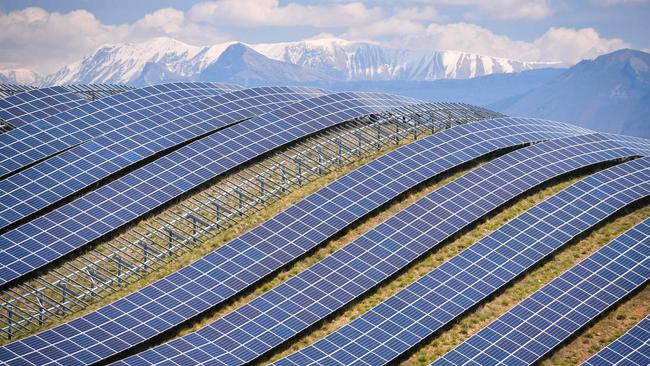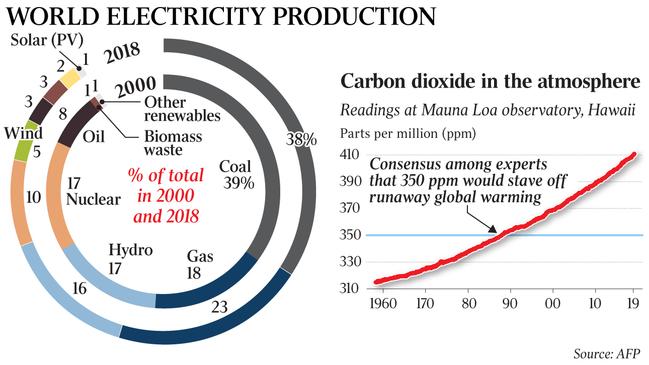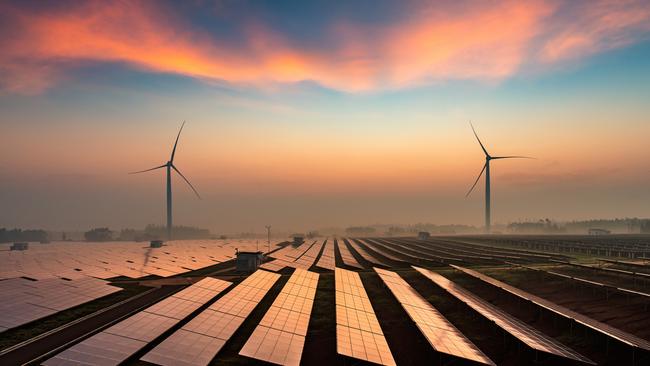Australia faces global warming grilling at Bonn climate conference
The climate change glitterati meet this week in Germany where energy politics faces scrutiny.

Having survived the winter chills of Poland in December, the climate change glitterati are meeting again in Bonn, Germany, this week to keep the rebranded “climate emergency” on track.
Australia has sent a delegation headed by climate ambassador Patrick Suckling to be grilled on the nation’s response to global warming.
Formal answers have been given to 20 written questions on how Australia plans to meet its Paris Agreement obligations.
Alongside Britain, South Africa, Brazil, Japan and Russia, Australian officials will have their climate efforts scrutinised by their peers.
The workshop-like format is designed to provide an opportunity for countries to share and learn from others about successes and failures when implementing their commitments.
Contrary to much of the domestic commentary, Australia has quite a lot to share.
MORE: Solar, gas to lead the way
Last year Australia was the world´s fifth biggest investor in renewable energy. While total carbon dioxide emissions increased 0.7 per cent last year the carbon intensity of the economy overall, the real objective, has been on a steep decline.
The December 2018 Quarterly Update of Australia’s National Greenhouse Gas Inventory showed emissions per capita in the previous year had fallen 38.2 per cent since 1990, while the emissions intensity of the economy had fallen 61 per cent.
Energy and Emissions Reduction Minister Angus Taylor says renewable energy projects already in the pipeline will help ensure Australia meets its declared Paris Agreement target of 26 per cent to 28 per cent below 2005 levels by 2030 almost a decade ahead of schedule. Independent analysis by Bloomberg has confirmed Taylor’s view.
Weathering criticism
Australia no doubt will continue to face criticism for not promising to do enough quickly enough.
But, put bluntly, the global community is in no position to lecture. A study published in Geophysical Research Letters found none of the major carbon emitters, including the US, China and the EU, has made commitments calculated to align with the Paris Agreement target of limiting climate warming to a 2C increase above pre-industrial levels.
This week the EU has struggled to agree on a uniform position for carbon neutrality by 2050.
The truth is that even the insufficient targets that already have been set are unlikely to be met by many countries.
Britain, meanwhile, has adopted the controversial position for which Australia has been criticised and will count additional carbon dioxide emissions savings from the Kyoto process towards its Paris target.

Coal and gas back
Behind the politics is the bigger truth that delivering on climate objectives will require much more than targets and slogans.
The big question is whether existing technologies will be capable of delivering what climate scientists say is required.
Two reports from opposite ends of the energy spectrum, one from oil and gas giant BP and another by the UN’s own renewable energy advisory body, REN21, broadly have come to the same conclusions.
The world’s addiction to energy shows no signs of slowing. Global emissions and fossil fuel use are up. Momentum is back with coal and gas. The trillions of dollars spent on renewable energy so far have failed to dent the dominance of fossil fuels in a much expanded total energy market.
Despite all the claims that renewable energy is the cheapest option, the evidence still is that investment collapses without subsidies and government mandate. This was proved true of solar in China and Britain last year. The number of home solar installations in Britain fell by 94 per cent last month after the government scrapped subsidies.
Most wind investment in the US can be traced directly to generous tax concessions. Concessions were designed to kickstart a transition that would build on its own momentum.
But according to REN21, total investment in renewable energy last year was down 11 per cent with India and Japan going sharply backwards.
In short, the much anticipated acceleration in the energy transition appears to have flatlined or faltered. As a result, the biggest names in solar and wind across the world are facing financial peril. Economist Joseph Schumpeter’s theory of creative destruction suggests harsh financial times may lead to greater efficiencies and lower prices.
But the scale of the challenge and outlook remain stark when the contribution of renewable energy is viewed in terms of total energy consumption.
As spending on new generation continues — more than $US1.2 trillion ($1.74 trillion) in the past five years — the size of the problem gets bigger. Solar and wind have chipped away at electricity but that sector accounts for only 18 per cent of total energy demand. When it comes to heating and transport and the other 80 per cent of the total energy market, wind and solar have yet to make much of a dent.
According to the highly respected BP statistical analysis, global emissions were up 2 per cent last year as the unexpected return to coal gathered pace.
BP says last year’s global energy demand and carbon emissions from energy use had grown at its fastest rate since 2010-11.
BP chief economist Bob Dudley says last year’s figures show that globally there was “a growing divide between societal demands for an accelerated transition to a low carbon energy system and the actual pace of progress”.

Lacking energy
Despite the continuing rapid growth in renewable energy last year, it provided only a third of the required increase in power generation, with coal providing a broadly similar contribution.
“Decarbonising the power sector while also meeting the rapidly expanding demand for power, particularly in the developing world, is perhaps the single most important challenge facing the global energy system over the next 20 years,” Dudley says. “Renewable energy has a vital role to play in meeting that challenge. But it is unlikely to be able to do so on its own.”
The REN21 report confirms the findings of the BP report but draws a different conclusion.
It says although renewable electricity is gaining ground quickly in many individual countries and regions, it faces challenges in achieving a larger share of the global total.
This is due mainly to continued strong growth in total electricity production (4 per cent last year) as well as to persistent investment in fossil fuel and nuclear power capacity and subsidies.
Two graphics in the REN21 report tell the story.
Wind and solar’s share of global electricity production was less than 8 per cent last year.
Out of an estimated 26,698 terawatt hours of electricity generated, 5.5 per cent was from wind energy (1471TWh) and 2.4 per cent was from solar photovoltaic panels (640TWh).
In terms of total energy production, including transport, heat and cooling, the contribution from renewable energy sources including wind, solar, biomass, and ocean power in 2017 was 2 per cent.
Like BP, REN21 found global energy demand had experienced its greatest rise in a decade last year, up 2.3 per cent. This was due to strong global economic growth (3.7 per cent) and to higher heating and cooling demand in some regions. China, the US and India together accounted for almost 70 per cent of the total increase in demand.
With fossil fuel use up, global energy-related carbon dioxide emissions grew an estimated 1.7 per cent during the year.
In short, the trillions of dollars spent to date on renewable energy have not been sufficient to stop the ship, let alone turn it around.
Paying the price
The answer, according to REN21, is to cripple fossil fuels further and to ramp up spending on renewables.
Rana Adib, executive secretary of REN21, tells The Australian there are different estimates for prospective renewable energy capacities and investment needed to reach the Paris and sustainable development goals.
One estimate says that to limit the rise in global mean temperature to 2C by 2100 with a probability of 66 per cent, in line with the objectives of the Paris Agreement, the share of all renewables including hydro-electricity and biomass in the primary energy supply must rise from about 15 per cent in 2015 to about 65 per cent in 2050.
Another model says the required proportion of electricity generated from renewables in 2030 is 73 per cent.
According to Adib, this would correspond to an installed renewable energy capacity of 25,700 gigawatts in 2050.
Considering the 2378GW installed by the end of last year, that would require 23,322GW in the next 31 years, or 752GW a year. Only 181GW of renewable power capacity was installed last year.
In financial terms, renewable energy spending will need to be boosted to between $US442 billion and $US650bn a year until 2030, compared to renewable energy investment last year of $US280bn. In other words, investment needs to more than double across the board.
The problem, however, is about more than money.
As the penetration of intermittent sources of energy increases, the problems already apparent in parts of Australia with reliability and price are becoming real concerns around the world.
The REN21 report says there are still challenges to address for solar PV to become a major electricity source worldwide. These include the need to integrate solar PV into electricity markets and systems in a fair and sustainable manner.
Taylor says Australia has already locked in a further $25bn in renewable energy investments.
“But we shouldn’t understate the unintended consequences of what we are seeing here in terms of reliability and affordability challenges,” Taylor told an industry conference last week.
“The future is about carefully incorporating new technologies into our energy systems while we maintain a balance with those older technologies.”
According to US pro-nuclear environmentalist Michael Shellenberger, the value of energy from solar and wind inevitably declines as more is added to the grid.
He says the underlying reason is physical. Solar and wind produce too much energy when it is not needed and not enough when it is. One response is bigger storage and better network management.
But Shellenberger argues the renewables-powered economy is circular, but not in a way that produces abundant energy for infinite recycling.
“Rather, renewables-powered economies are circular in the sense of spiralling downward, as in a drain, or like a snake eating its tail until there is nothing left,” he says.


To join the conversation, please log in. Don't have an account? Register
Join the conversation, you are commenting as Logout